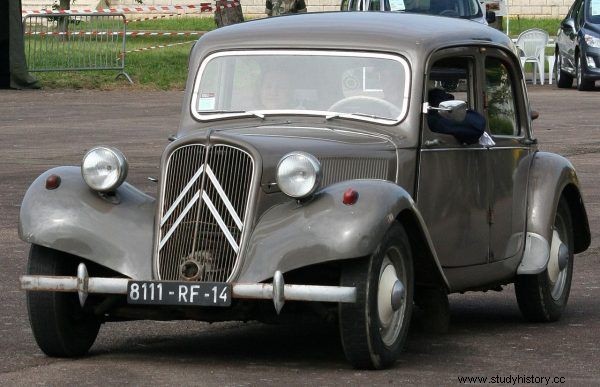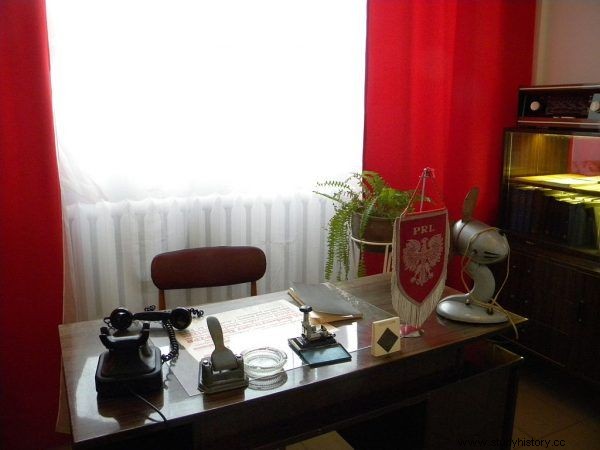The communist authorities have built a surprisingly efficient system of controlling society. The services, looking for enemies of the socialist homeland, had a rich technical arsenal at their disposal. They operated consistently and on a large scale - as a result, no one could be sure that it was not wiretapped ...
The seeds of security organs, modeled on the Soviet structures, were created in Poland during World War II. On July 21, 1944, the Department of Public Security was established, which gained new ranks in the following months. In 1945 it was transformed into the Ministry of Public Security (MBP).
The beginnings of these services are associated with thousands of arrests and murders of citizens who did not accept the post-war balance of power. The beastly era did not end until 1954. As Monika Komaniecka writes, dealing with the history of the communist secret police:
In September 1954 there was a ferment in the ranks of the communist party due to the broadcasting of the first program on Radio Free Europe, in which Lt. Col. Light revealed the backstage of the secret police. As a result, there were changes in the party apparatus. [...] The Ministry of Public Security was dissolved and on December 7, 1954, two bodies were established:the Committee for Public Security (KdsBP) and the Ministry of the Interior (MSW).
However, it was only the events in Poznań in June 1956 that initiated the creation of the apparatus of repression of citizens, known as the Security Service (SB). Placing it in the structure of the Ministry of Internal Affairs allowed the state authorities to use a whole set of technical means of repression. Already in the following year, the secret police included ten units. It was the intelligence (Department I), counterintelligence (Department II), the unit for combating anti-state activities in the country (Department III), the Operational Records Bureau, as well as the “A”, “B”, “T” and “W” Offices. The latter dealt with (respectively) ciphers, external observation of Polish citizens, operational technique and correspondence control.

The MBP, whose officers were recognized by their characteristic cars, existed until 1954.
Modern methods of surveillance
SB gradually developed further methods of working in the field. This is evidenced by the number of letters viewed in the first years of its operation. In 1957, there were several hundred of them - at least in the light of the available data - all over the country. Two years later, more than half a million were inspected… in the second quarter alone!
However, reading correspondence or browsing printed papers was not the main area of the security services. After all, it gained a special unit ("T" Office), which soon grew to an impressive size. Its very structure allows us to show how multi-level and multi-faceted the supervision over citizens potentially hostile to socialism has become . This is how Robert Ciupa and Monika Komaniecka introduce her:
Office "T" gradually expanded. In 1965, there were nine departments:telephone wiretapping (I), room wiretapping (II), room wiretapping at diplomats and hotels (III), inspection and penetration (IV), legalization (V), chemistry and expertise (VI), installation room eavesdropping (VII), general and technical supply (VIII), development, assembly and repairs of equipment (IX). In addition, there were two separate sections:Section "S" (pharmaceutical development) and Section "F" (financial), as well as workshops for the manufacture of equipment.
Bugged
With the development of technologies used to spy on and eavesdrop on Poles, the "T" Office and its provincial departments in MO headquarters have gained in importance. Initially, they were used as an auxiliary service, but from the 1960s, various operational techniques were used more and more often. Room, telephone and telegraph wiretaps were installed. Pictures were also taken from hiding and the suspects were filmed. A covert search is also on the list of activities.

What was the procedure for operating when the services wanted to start listening? It was quite legible. It was enough for a specific security unit to ask the "T" department to use one of the operational techniques. Before the operation was launched, not only the provincial commander of the MO had to approve, but also the minister of the interior himself.
After obtaining the appropriate consent, it was possible to enter the action. The first step of the SB officers, who, for example, was commissioned to plant a bedbug, was to carry out an appropriate survey in the field to avoid exposing too quickly. At this stage, the rooms in which the wiretapping was to be conducted were selected. The premises of private persons were often used, although it also happened that the SB operated on the premises of public institutions.
The officers also had to create a possibly credible "legend" explaining their presence in a given place. Thanks to this, if they had any questions, they had an answer ready. Most often they also involved the owner of the room into cooperation. The next step was to install the necessary equipment, which was done by the technical department. How did it look like? Komaniecka and Ciupa explain:
The wiretap could be established by the officers entering the apartment, i.e. secret entrance . It was always done in the absence of the household. The second method of installation was to use the transitional premises, i.e. the adjacent room. [...] The wiretap recording took place in the so-called collection point - that is, the premises located at a distance from the apartment in which the wiretap was installed. An officer of the exploitation section was responsible for receiving the signals and recording them on tapes.

The wiretap was placed in such a way that it was as difficult to find as possible - for example in a chandelier. Illustrative photo.
The (former) agent Bruno Kowalsky also tells about the devices installed by the security services in the book “How much do they know about you? Spies and wiretaps in Poland ” . As he tells his interlocutor, Krzysztof Pyzi:
Eavesdropping was often installed through the wall of an adjoining apartment or through the ceiling in the apartment upstairs. All this to let the listening microphone, for example, into a chandelier . Thanks to this, nobody noticed, because how often do you deal with this element of decor, apart from replacing the light bulb?
It is worth adding that the equipment used by the security services was completely unavailable to the average Kowalski. The devices used for wiretapping, i.e. MAK 2s tape recorders, were produced only for the needs of radio, television and ... the Security Service . Their construction was so advanced that it did not require the presence of an officer. At the moment when there was silence in the room being eavesdropped, the recording was automatically turned off.
The Golden Age of the Security Service
The beginnings of the SB activities were not spectacular, because Władysław Gomułka had limited confidence in it. Although he was well aware of their key role in the functioning of the Polish People's Republic, he did not have a great understanding of the way they functioned. As a result, as Bruno Kowalsky claims, “it was very fragile for Gomułka's comrade with Polish intelligence, he almost destroyed him. He felt it was unnecessary and therefore cut his finances as much as he could. ”

The SB had a whole arsenal of eavesdropping techniques. Illustrative photo.
The decisive moment in the development of the secret police, however, was the change in the position of the First Secretary of the PZPR in 1970. At that time, the party was headed by Edward Gierek, who had a completely different approach to the issue of security and surveillance. "It was then, in 1972, that the" spy school "began to operate, i.e. the secret Intelligence Staff Training Center in Stare Kiejkuty, which is said to function until today," reports Kowalsky.
The Security Service grew in importance with each successive year, although it was the seventies that were crucial for the development of individual divisions. In addition, esbecas then gained access to more modern photographic and audiovisual equipment . At the same time, the SB was an increasingly less transparent structure, as the methods and environment of work became more and more entangled in numerous political and business games. Intelligence was slowly becoming a state of the state. As Bruno Kowalsky tells in his book How much do they know about you? Spies and wiretaps in Poland ” :
In the Polish People's Republic, there was no major surveillance of the intelligence service. Let's be clear - if there was such a control, it was only superficially. There were such absurdities that Edward Gierek claimed that the secret services were behind the August strikes in 1980. He was said to have said that this was an SSB provocation initiated by people associated with Secretary Kania!

The security grew in strength during the reign of Edward Gierek.
Final show
The average citizen of the People's Republic of Poland did not even suspect that people who had anything to do with the intelligence were hanging around him every day . Only meticulous calculations by researchers revealed the scale of Polish services' activities towards citizens. Since almost a thousand people worked in the "T" office throughout the period of the People's Republic of Poland, it can be concluded that the number of Poles observed was counted in thousands, if not tens of thousands. Besides, not only the services were eavesdropping - an inadvertently thrown word could have been intercepted by a neighbor or colleague who joined the group of secret collaborators, which included tens of thousands of Poles.
The Security Service finally ended its work in April 1990. Out of 24,000 officers, 14,000 were subject to a verification process, which positively exceeded 10,000. The SB was succeeded by the UOP, which took over from its predecessor a lot of work techniques ... and even more political and business ties, which significantly influenced the beginning of the transformation in the Third Polish Republic.
Bibliography:
- Monika Komaniecka, Observed and eavesdropped , Dante Publishing House 2014.
- Robert Ciupa, Monika Komaniecka, The spy arsenal of the security services , IPN 2011.
- Krzysztof Pyzia, Bruno Kowalsky, How much do they know about you? Spies and wiretaps in Poland , Prószyński i S-ka 2019.
